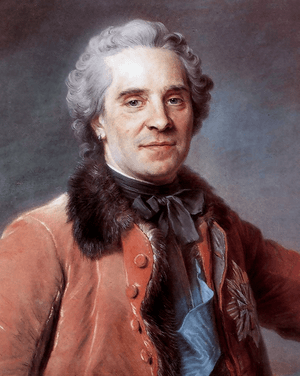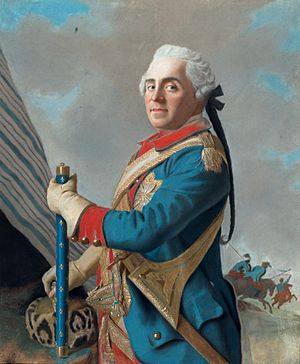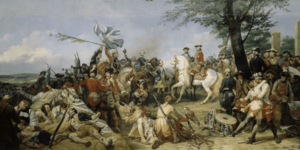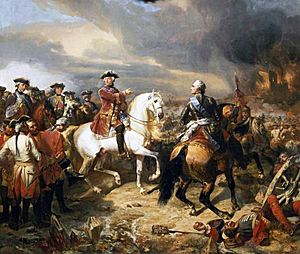Maurice de Saxe facts for kids
Quick facts for kids Maurice de Saxe |
|||||
|---|---|---|---|---|---|
| Count of Saxony Marshal General of France |
|||||

Maurice de Saxe wearing the Polish Order of the White Eagle, 1748
|
|||||
| Born | 28 October 1696 Goslar, Holy Roman Empire |
||||
| Died | 20 November 1750 (aged 54) Château de Chambord, Kingdom of France |
||||
| Burial | Saint Thomas Church, Strasbourg | ||||
| Spouse | Johanna Viktoria von Loeben | ||||
| Issue | August Adolf von Sachsen Marie-Aurore de Saxe |
||||
|
|||||
| Father | Augustus II of Poland | ||||
| Mother | Maria Aurora of Königsmarck | ||||
| Signature | |||||
Maurice, Count of Saxony (born October 28, 1696 – died November 20, 1750) was a very important soldier and military leader in the 1700s. He was the son of Augustus II the Strong, who was the King of Poland. Maurice first served in the army of the Holy Roman Empire, then joined the French army. He became a Marshal of France and later a Marshal General of France, which was a very high rank. He is most famous for his actions in the War of the Austrian Succession, especially his big win at the Battle of Fontenoy.
Contents
Early Life
Maurice was born in Goslar. His mother was Countess Maria Aurora of Königsmarck, and his father was Augustus II the Strong, King of Poland. He was one of his father's many children born outside of marriage.
In 1698, Maurice's mother sent him to live with his father in Warsaw. Because Poland was not very stable at the time, Maurice spent most of his childhood outside the country. Being away from his father helped him become very independent, which was important for his future as a military leader.
Military Career



Early Military Service
Maurice started his military career very young. At just 12 years old, he joined the Imperial Army. He fought under a famous general, Prince Eugene of Savoy, in battles like the sieges of Tournai and Mons, and the Battle of Malplaquet. Prince Eugene once told him to be brave, but not reckless.
Later, he fought alongside Peter the Great against the Swedes. In 1711, his father officially recognized him and gave him the title of Count. By the age of 17, in 1713, Maurice was already leading his own group of soldiers in the Royal Saxon Army.
Maurice was very strong, like his father. He could even bend a horseshoe with his bare hands! He had a lot of energy and could keep going even when he was sick.
Joining the French Army
In 1714, Maurice married Countess Johanna Viktoria Tugendreich von Loeben, who was very wealthy. However, he quickly spent her money, and they separated in 1721. They had a son, August Adolf, who sadly lived only a few hours.
After fighting in a war against the Ottoman Empire in 1717, Maurice went to Paris to study mathematics. In 1720, he became a field marshal in the French army.
War of the Austrian Succession
Maurice played a big part in the War of the Austrian Succession. He served under Marshal Berwick. For his brave actions at the Siege of Philippsburg, he was promoted to lieutenant-general.
In 1741, Maurice led an army division to invade Austria. On November 19, 1741, he surprised and captured Prague during the night. This clever move made him famous across Europe. After capturing another fortress, Eger, he was given a break.
Maurice's successes were a bright spot in a difficult war for France. On March 26, 1743, he was rewarded by being promoted to Marshal of France. He was given a smaller army but managed to defend against much larger enemy forces without risking a major battle.
In 1744, Maurice was chosen to lead a French invasion of Britain. However, the plan failed when terrible storms wrecked the ships shortly after they left port. After this, he was given command in the Netherlands. He used smart tactics to bother the enemy's larger forces without fighting a big, risky battle.
Great Victories
In 1745, Maurice and his 65,000 men surrounded Tournai. He then led his army to a big victory over the Duke of Cumberland's forces at the Battle of Fontenoy. Maurice was very sick during this battle and couldn't ride a horse, so he was carried around in a special wicker chair. His calm and steady leadership helped win the battle.
Because of his amazing achievements, King Louis XV gave him the Château de Chambord for life. In April 1746, Maurice became a French citizen. He continued to lead the French army in the Netherlands with great success until the end of the war. Besides Fontenoy, he also won battles at Rocoux (1746) and Lawfeldt (1747).
Under his command, the French captured Brussels. His general, Marshal Löwendahl, also captured Bergen op Zoom. Maurice himself won the last major victory of the war by capturing Maastricht in 1748. In 1747, he was given the special title of "Marshal General of the King's camps and armies," a title only held by a few great generals before him.
Maurice de Saxe died on November 20, 1750, at the Château de Chambord.
Writings
Maurice de Saxe wrote a book about the art of war called Mes Rêveries (My Reveries). It was published after his death in 1757. Even Frederick the Great, a famous military leader, praised it. Much later, in the 1900s, Lord Montgomery called it "a remarkable work on the art of war."
In his book, Maurice de Saxe suggested new ideas for warfare. He believed that armies should focus more on moving quickly and fighting battles, rather than just defending strong forts. He also thought that French soldiers should use different tactics than other armies, because of their unique character.
Some of his other writings, called Selected Letters and Memoirs, were published in 1794.
Legacy
After Maurice de Saxe died, a special ceremony was held for him in Paris. However, because he was a Protestant, he could not be buried there. His body was taken to Strasbourg.
King Louis XV asked for a permanent tomb to be built for him. This beautiful monument was created by Jean-Baptiste Pigalle and is now in St Thomas' Church, Strasbourg. The monument shows Death holding an hourglass, calling Maurice to his grave. France is shown crying and trying to hold him back, while Hercules weeps. On one side, there are sad animals representing France's enemies, with their broken flags. On the other side are France's winning flags. In the middle, Maurice stands heroically, not afraid of his fate.
Many books have been written about Maurice de Saxe's life. He is also honored in the Walhalla Memorial, a hall of fame in Germany.
Images for kids
See also
 In Spanish: Mauricio de Sajonia (1696-1750) para niños
In Spanish: Mauricio de Sajonia (1696-1750) para niños

